 |
 |
|
 |
Employees to observe Worker Memorial Day on April 28 |
 |
 |
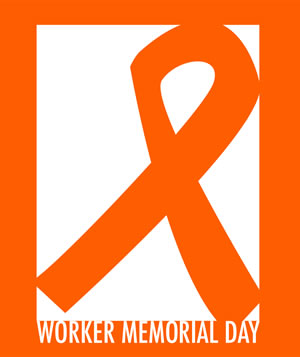 |
|
Mn/DOT employees statewide will observe a moment of silence at 2 p.m. on April 28 to honor their colleagues who have been injured or killed on the job. |
Mn/DOT employees statewide will observe Worker Memorial Day on April 28 at 2 p.m. to remember colleagues who have been injured or killed on the job.
Since 1960, 29 Mn/DOT workers have died in work-related incidents, many of them struck down by motorists in the work zone. The most recent fatality came with the death of Ed Stary Jr., a Metro District transportation specialist senior, who was killed last June in a truck accident.
This year, a videotaped message from Lt. Gov./Commissioner Carol Molnau will be broadcast at 2 p.m. to employees’ desktops and videoconference rooms via the Web. Audio versions of Molnau’s message also will be played in some work areas. She will lead employees in a moment of silence to honor fallen colleagues.
Some districts also are marking the day with short programs and guest speakers. Metro District’s speakers will include Vicki Stary, the widow of Ed Stary, as well as representatives from the Minnesota State Patrol, American Federation of State, County and Municipal Employees and Mn/DOT.
In addition, District 3 will be unveiling a plaque honoring district employees who have died while employed at Mn/DOT, while District 7’s AFSCME Local 280 has planned a simple gathering at noon at the Mn/DOT headquarters, with a lunch afterwards.
District 4 included an observance of Worker Memorial Day at its all employee meeting on April 26.
For more information about work zone safety: http://www.dot.state.mn.us/workzone/index.html.
|
back

|
 |
Park Rapids celebrates opening of new Wayside Rest Area complex |
 |
 |
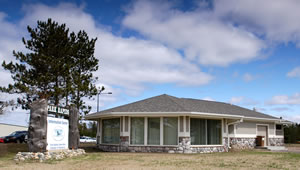 |
|
The Park Rapids Lakes Area Chamber of Commerce Wayside Rest Complex, located on Hwy 71 just south of Park Rapids, officially opened April 22. Photo by David Gonzalez |
The grand opening of the new Park Rapids Lakes Area Chamber of Commerce Wayside Rest Complex occurred April 22 with a ribbon-cutting ceremony featuring representatives from Mn/DOT, Hubbard County, the city of Park Rapids and the chamber of commerce.
The complex, located on Hwy 71 just south of Park Rapids, features a rest area, chamber offices with tourist information and an adjacent All Veterans Memorial Park.
“This is a terrific facility that does double duty–it serves as a wayside rest and a tourist information center,” said Lt. Gov./Commissioner Carol Molnau. “It is a true partnership project that allows Mn/DOT to effectively provide a higher level of service to motorists, while still controlling public expenses.”
Molnau added that budgets everywhere, especially operating budgets, are tight and that Mn/DOT will continue to seek partnerships that reduce overall costs for the agency or use cost-effective ways to improve services needed at rest areas.
According to project engineer Duane Hill, Mn/DOT made the capital investment, about $627,000 in construction costs, while the local partners—the city, the county and the chamber—are paying most of the operating and maintenance costs. He said that Mn/DOT’s contribution is limited to two hours per day of custodial services through the summer travel season and to the provision of landscape plantings that will be installed by area volunteers.
In addition to Molnau, featured speakers included Park Rapids Mayor Ted Godfrey, Park Rapids Chamber of Commerce President Curt Domino and Hubbard County Commissioner Chairman Floyd Frank. Also attending were Mn/DOT District 2 staff and elected officials serving the Park Rapids and Northern Minnesota areas.
By Jeanne Aamodt
|
back

|
 |
Bois Forte, Mn/DOT sign agreement on Indian employment |
 |
 |
Mn/DOT and the Bois Forte Reservation Council signed an agreement on April 19 to work together to increase employment of American Indians on transportation projects on or near Indian Reservation lands.
The agreement, signed by Kevin Leecy, chairman, Bois Forte Reservation, and Lt. Gov./Commissioner Carol Molnau, specifies ways that Mn/DOT and the tribe will work to promote hiring Indian people.
The Bois Forte Tribe is the sixth Minnesota tribe to sign a similar agreement with Mn/DOT.
The other tribes are: Leech Lake, Red Lake, Shakopee Mdewakanton, Upper Sioux and White Earth.
Additional information:
By Kay Korsgaard
|
back

|
 |
District 6 receives environmental award for Salt Solutions program efforts |
 |
 |
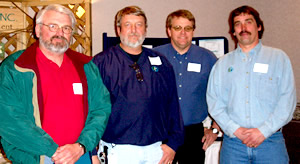 |
|
District 6 staff accepting the award include (from left) Tom Fargusson, Dave Redig, Brian Wolfgram and Scott Allen. Photo by Kristine Hernandez |
Rochester/District 6 earned an award for environmental leadership for carrying out the goals of Mn/DOT’s Salt Solutions program to use de-icing chemicals more effectively, including reduced salt use.
The Freshwater Society, Excelsior, and the Fortin Consulting Inc., Hamel, presented the award at the annual Road Salt Symposium in St. Cloud, said Kristine Hernandez, district public affairs coordinator.
The annual meeting brings environmental groups, policy makers, chemists, transportation departments and the de-icing industry together to examine the environmental effects caused by salt and other de-icers and the ways to lessen them.
The Rochester District began its transition to a more environmentally sound snow and ice control effort in 1997 when it joined the Salt Solutions program. Each year, the district trains maintenance employees on the use of equipment, chemicals and application methods for optimal chemical use, Hernandez said.
The award cites the district’s achievements to reduce salt use and its continued efforts such as evaluating new de-icing chemicals and applying best management practices in snow and ice control operations.
Staff who accepted the award on behalf of the district are Dave Redig, maintenance superintendent at Rochester; Wes Smith, maintenance superintendent at Owatonna; Tom Fargusson, Albert Lea subarea supervisor; Brian Wolfgram, transportation specialist, Maintenance Operations at Rochester; Scott Allen, Salt Solutions coordinator, Dresbach truck station, and Dave Serrano, Stewartville truck station, the former Salt Solutions coordinator.
By Craig Wilkins
|
back

|
 |
Spring maintenance expo focuses on highway workers’ safety |
 |
 |
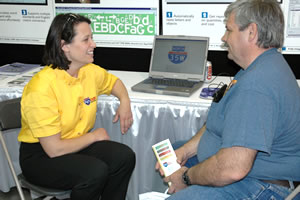 |
|
Wayne Learn, a transportation generalist at the Red Wing truck station, hears about programs that operate and manage traffic control devices from Emily Fischer, a salesperson with a Minnetonka-based software firm. Photo by Craig Wilkins |
Maintenance forces from Mn/DOT and other agencies learned ways to keep themselves safe—from using sunscreen to securing loads—during the 2005 Minnesota Spring Maintenance Expo held April 20-21 in St. Cloud.
The annual event brought maintenance workers, supervisors and managers together to explore ways to do their jobs more effectively and more safely.
Safety was a key aspect of this year’s spring expo.
Staff members from a St. Cloud plastic surgery clinic said that using sunscreen, wearing hats and other protective clothing are necessary to prevent skin cancer and other conditions caused by exposure to the sun’s rays.
Maretta Johannes said more than a million new cases of skin cancer are reported each year in the United States. The vast majority of them, she said, are caused by prolonged exposure to sunlight, particularly among people who work outdoors.
Johannes advised year-round use of sunscreen, for example, not just during the warm and sunny spring and summer months.
“The sun’s most harmful rays—ultra violet A and ultra violet B—can easily penetrate clouds, glass and clothing, that’s why limiting sun exposure is a wise choice year-round,” she said.
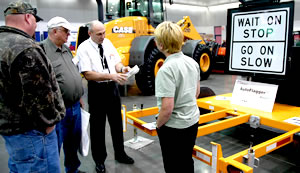 |
Learning about the Auto-Flagger’s operation from a vendor are (from left) Dean Raymond, senior transportation generalist, North Branch truck station; Jerry Anderson, supervisor at the Spring Lake Park truck station, and Kathy Schaefer, a trainer with the Local Technical Assistance Program. Photo by Craig Wilkins |
Rick Shomion, Maintenance Operations & Research, led a workshop where video presentations stressed safety in operations such as mowing, securing heavy loads to flatbed trucks and flagging.
The expo’s equipment and product display featured the Auto-Flagger, which allows flaggers to control traffic entering a work zone from an off-road location using a remote-control transmitter. Rochester/District 6 currently uses the Auto-Flagger; Duluth/District 1 has ordered one.
Other displays included services such as planning shoulder and ditch restorations and creating computer programs to operate highway advisory signs; equipment such as special use mowers, skid steers, and products such as plastic mats to prevent weed growth under guard rails and around signs, said Ken Nelson, Maintenance Operations & Research.
Nelson said the Metro District will use the plastic mats at several locations this spring.
Participants in one workshop session learned to deal with risks associated with roadside debris and other side effects from drugs made in “ meth labs,” a growing problem throughout the state.
For example, maintenance crews should not handle materials that may have been used for methamphetamine production such as containers for propane and anhydrous ammonia, according to presenter Paul Stevens, Bureau of Criminal Apprehension. He also suggested that if crew members encounter people involved in meth production, they should act very slowly and deliberately to avoid startling them.
Other workshop topics addressed safe chainsaw operation, controlling traffic in work zones, reducing risk from the mosquito-borne West Nile virus, and pavement preservation methods.
The spring expo was sponsored by the Local Technical Assistance Program, Center for Transportation at the University of Minnesota; the Local Road Research Board, the Minnesota Street Superintendents Association, the Minnesota Public Works Association and Mn/DOT.
Assessing the value of the expo, Shomion said, “I think the participants walked away with a better sense of how to protect themselves and the traveling public—from personal care to setting up lane closures properly to ensure greater safety in highway work zones.’
By Craig Wilkins
|
back

|
 |
Middle-schoolers’ donation sweetens District 7’s Adopt-A-Highway program |
 |
 |
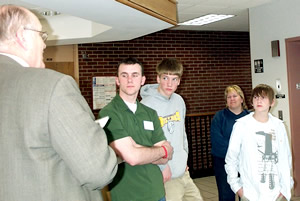 |
|
Jim Swanson, left, District 7 transportation engineer, accepts a check for $150 from eighth graders from the Dakota Meadows middle school in Mankato. The students donated the money to the district's Adopt-A-Highway program, which is coordinated by Carol Wheeler, second from right. Photo by Rebecca Arndt |
Eighth graders from a Mankato middle school turned proceeds from an ice cream sale into plastic bags and orange vests worn by volunteers to support Mankato District’s Adopt-A-Highway program.
Theirs is the first cash donation made to the AAH program in the district.
The students, eight in all, are enrolled in a voluntary public achievement group at the Dakota Meadows school, said Carol Wheeler, AAH coordinator at Mankato . Students majoring in social studies at Minnesota State University-Mankato coach the group.
A focus on the environment, Wheeler said, led the students to concentrate on litter. Because forming their own AAH group wasn’t feasible, the students decided to raise funds to support the program.
After getting the go-ahead from District 7 officials, the students raised $150 from an ice cream sale during a school dance in March.
Jake Dickinson, an eighth-grader, said the group chose the AAH effort to support because of its concern for the environment.
“We know our environment is very polluted and we want to do whatever we can to help it out,” he said.
Students and coach Dave Gindorff presented the check to the district on April 14; the participants received a plaque presented by District Engineer Jim Swanson for their efforts.
The funds will be used to purchase safety vests worn by volunteers, trash bags and other supplies. The district has a total of 579 volunteer AAH groups committed to clean more than 90 percent of the district’s roadsides.
“When they called, the students really caught me off-guard because I’ve never had a group want to raise money for our program,” Wheeler said. “Raising funds and working with our district has been a great learning experience for the students and for us.”
Dickinson said his group’s efforts on behalf of the environment are not over.
“We may plant a tree at our school on Earth Day,” he said.
By Craig Wilkins
5,000 volunteer groups participate in Adopt-A-Highway program’s 15th year
Since its beginning in 1990, Mn/DOT’s Adopt-A-Highway Program has involved thousands of volunteers who pick up litter from more than 90 percent of the state’s 12,000-mile trunk highway system.
Currently, there are about 5,000 volunteer groups representing more than 55,000 people who clean roadsides two or more times each year along sections of highway from two to three miles in length.
Cathy Ashfeld, Metro District, the state AAH coordinator, said that in the Twin Cities metro area alone, volunteers picked up more than 26,000 tons of litter in 2004.
Statewide, she said, the cost for disposing of litter collected along Minnesota’s trunk highway system tops $1 million per year.
Ashfeld notes that the cash donation to District 7 is not the first one received by the program.
In 1999, singer-actor Bette Midler, an ardent environmentalist, gave the program $500 after viewing the extent of litter along Interstate 35W on her way to perform in Minneapolis .
“That was pretty cool,” Ashfeld said.
|
|
back

|
 |
|
 |



